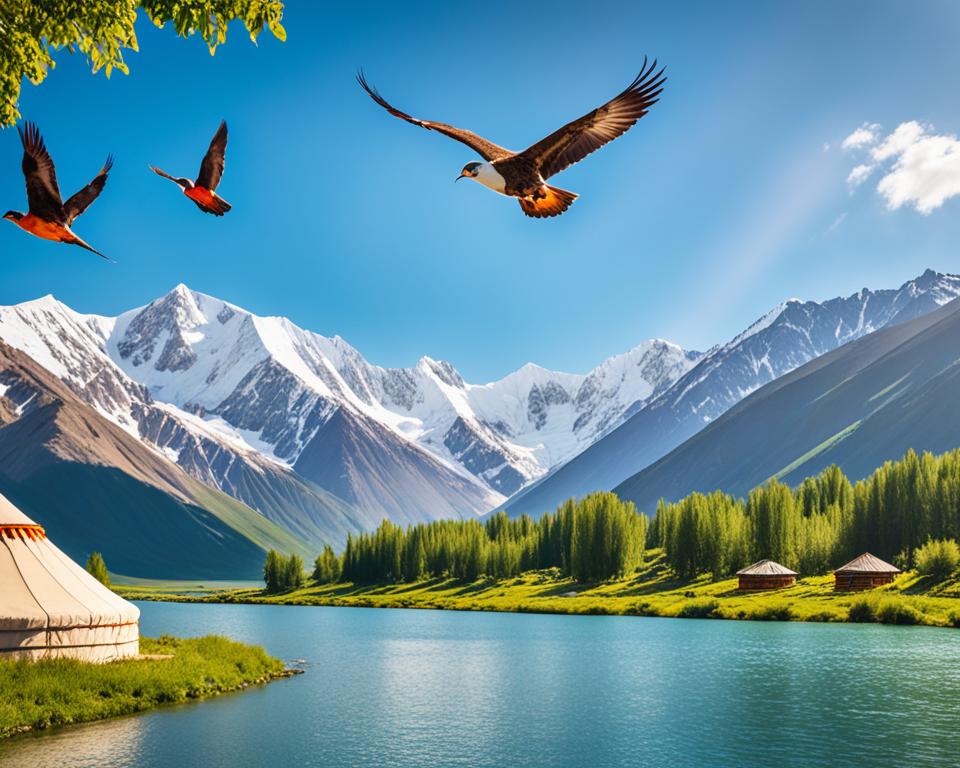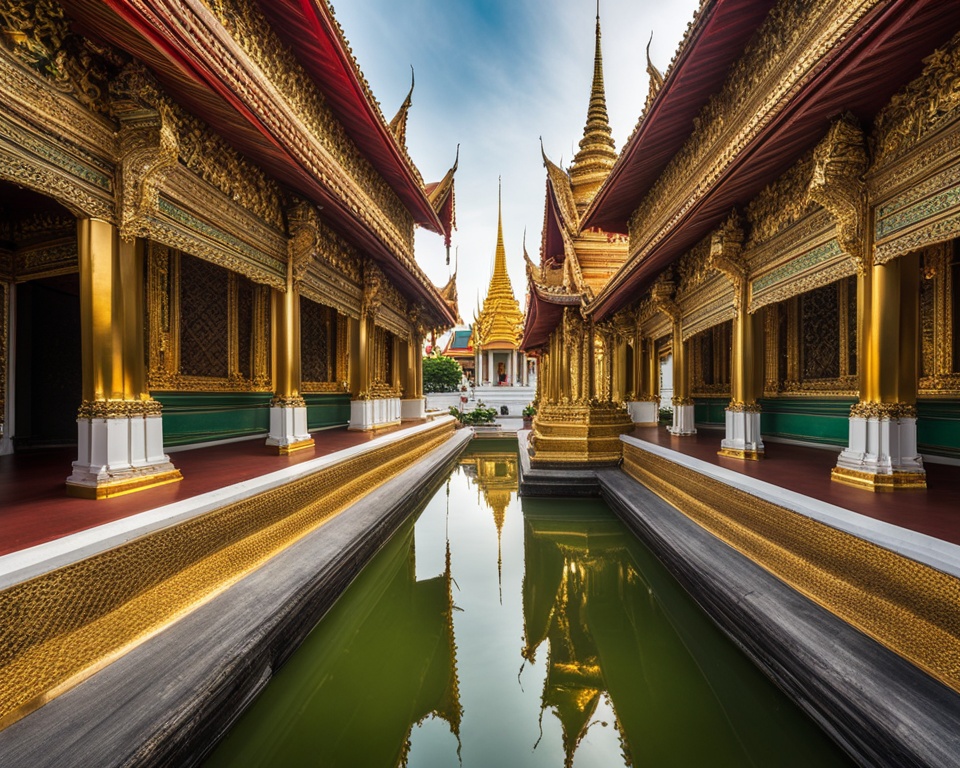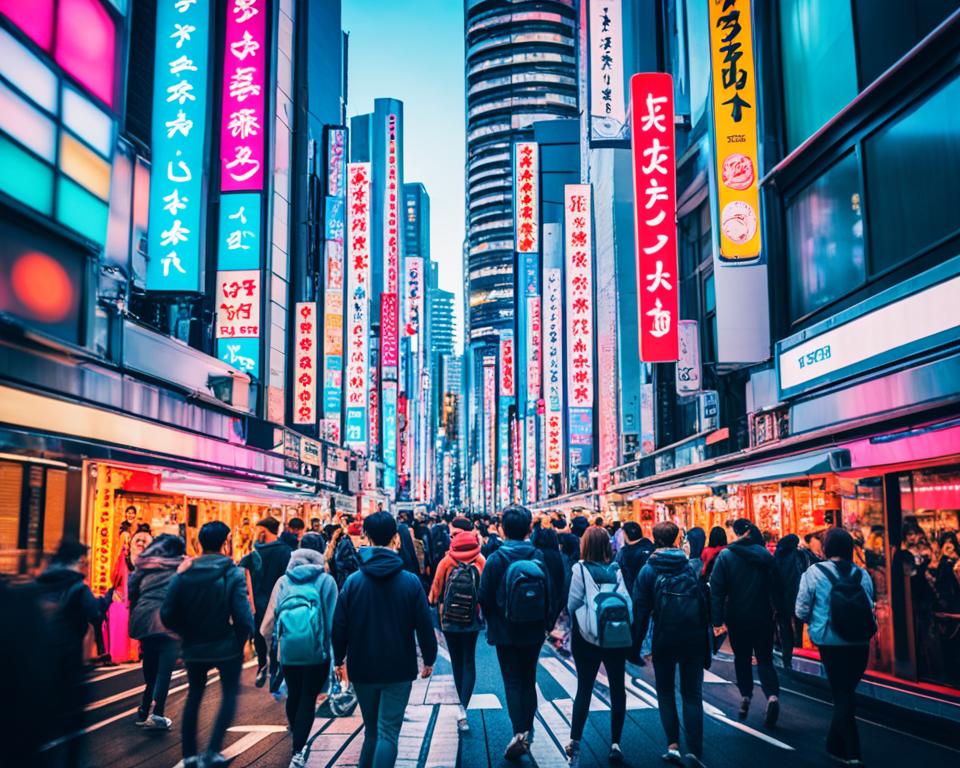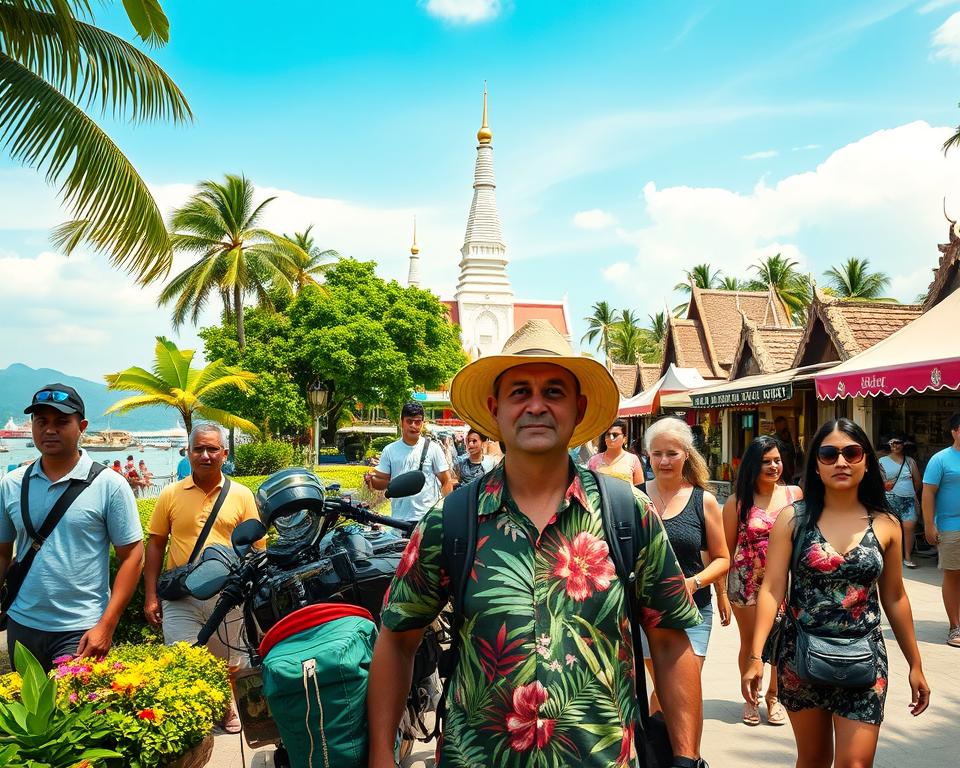Xinjiang, found in northwest China, is full of stunning sights, cultural history, and its connection to the legendary Silk Road. This guide takes you through the top xinjiang tourist attractions. From the calm Heavenly Lake of Xinjiang to the lively Kashgar Old Town, you’ll see Xinjiang’s diverse beauty. It’s perfect for those looking for history, nature, or to experience the local Uyghur culture.
Read more interesting information at ::kamarqgroup
Unveiling the Captivating Xinjiang Tourist Attractions
The sights of Xinjiang create a perfect mix of nature, history, and culture. For centuries, these have caught the attention of travelers. From famous Silk Road stops to the unique Uyghur culture, let’s explore the attractions that make Xinjiang special.
Exploring the Ancient Silk Road’s Iconic Destinations
Xinjiang played a key role along the Silk Road. Its location connected Asia and Europe, creating a rich historical tapestry. Visitors can walk in the footsteps of traders and scholars, seeing the ancient sites first-hand. This region was a hub for cultural exchange and trade.
Unveiling Xinjiang’s Diverse Cultural Heritage
Even beyond the Silk Road, Xinjiang’s culture stands out. The Uyghur people’s traditions are rich and unique, carried on for generations. You can join in local celebrations, visit traditional workshops, and meet with the warm locals, learning a lot about Xinjiang and its people.
The Awe-Inspiring Heavenly Lake of Xinjiang
The Heavenly Lake (Tianchi) sits beautifully in Xinjiang’s Tianshan Mountains, catching the eye of every guest. This glacial lake glistens with clear, blue waters. It’s backed by breathtaking peaks, making it a peaceful escape for anyone.
Embracing Nature’s Breathtaking Beauty
The Heavenly Lake shows off Xinjiang’s stunning nature. It’s hemmed in by big, snowy peaks. The scene is like a painting, with the mountains mirroring in the lake’s still waters.
People love just being there, breathing fresh air. They also enjoy spotting local plants and animals. It’s all part of a picture-perfect scene.
Hiking Trails and Scenic Vistas
There’s more to the Heavenly Lake than just its looks. Xinjiang hiking trails let you get close to nature. They offer amazing views of the lake and its mountain neighbors.
We encourage hikers to take these paths. It lets them see the lake’s beauty in a new way. Plus, you can spot wildlife in the area.
This place is great for both unwinding and exploration. If you love nature adventures, the Heavenly Lake is a top choice. It’ll make a lasting mark on your memories.
Bezeklik Thousand Buddha Caves: A Treasure Trove of History
The Bezeklik Thousand Buddha Caves take you back to the ancient Silk Road. They are from the 5th to 14th centuries. These cave temples have murals and Buddha sculptures that show the area’s religious and cultural history. For anyone who loves history, seeing the art and learning its meaning is a top activity in Xinjiang.
In the Flaming Mountains of Xinjiang, the caves show how important the area was on the Silk Road. Long ago, they were busy places of Buddhist prayer. Now, their walls and ceilings still show beautiful art. This art reveals both religious stories and the life of the ancient people here.
Today, the Bezeklik Thousand Buddha Caves are a special place for history and culture. They let visitors learn about Xinjiang‘s deep history. By seeing the artwork and understanding its context, you can learn about the Silk Road and the ideas it spread.
If you love history, new places, or ancient cultures, visit the Bezeklik Thousand Buddha Caves in Xinjiang. It’s a chance to be amazed by history and the art left behind. Uncover the secrets and stories hidden in these caves, and enjoy Xinjiang‘s rich culture.
The Mesmerizing Flaming Mountains: A Natural Wonder
The Flaming Mountains are located in the Turpan Basin. They attract visitors with their stunning red colors and dramatic shapes. These sandstone mountains have been shaped by wind and water over many years. They make a beautiful place for people to explore and take pictures.
Stunning Geological Formations
Hiking in the Flaming Mountains will leave you amazed. The rocks here seem to be from another world. There are high peaks, deep canyons, and rocks that twist in strange ways. The bright red and orange colors, especially in the hot sun, give them a fiery look. This is how they got their name.
Capturing the Essence of Xinjiang’s Landscapes
The Flaming Mountains are a dream for photographers. They offer beautiful scenes against the sky or close-up shots of the rocks. This area lets both pros and amateurs capture its wonder. Dive into the beauty of this natural spot. Let your camera show the stunning faces of this unique place.
Kashgar Old Town: A Step Back in Time
Kashgar Old Town tells the story of Xinjiang’s cultural heritage and the Silk Road’s lasting impact. Walk through its ancient alleys and bustling bazaars. You’ll see Uyghur architecture, find artisanal crafts, and smell spices that make you feel you’ve gone back in time.
Exploring the Ancient Alleys and Bazaars
Get lost in Kashgar Old Town’s vibrant local culture. Hear the daily life happening around you in the xinjiang markets. Talk to the vendors, look for special souvenirs, and see the traditions that make this historic Kashgar Old Town last over time.
Immersing in the Local Uyghur Culture
Feel the heart of Uyghur culture on the town’s winding streets. See artisans making beautiful things, taste real Uyghur food, and join in cultural events. These events show off the area’s deep cultural roots.
Discovering the Enchanting Muqam Culture
Xinjiang’s Muqam culture is a captivating musical tradition grown over centuries. It’s deeply tied to the Uyghur heritage. This musical style is a tapestry of diverse sounds and instruments, each with a unique story and role.
Experiencing Xinjiang’s Rich Musical Heritage
Step into the world of Muqam music. Skilled musicians combine detailed melodies, rhythmic patterns, and traditional instruments. From the dutar lute’s haunting tones to the satar fiddle’s mesmerizing harmonies, Muqam shows Xinjiang’s musical genius.
Attending Live Performances and Festivals
To fully experience Muqam, attend live shows or Xinjiang festivals. These events bring Muqam to life. You’ll see beautiful Muqam dancers and feel the energy of live performances, diving into Xinjiang’s muqam culture.
By exploring Muqam’s styles and watching performers, you learn about Xinjiang’s deep culture. It invites you to experience true Xinjiang traditions in a memorable way.
Savoring the Delectable Uyghur Cuisine
Uyghur cuisine is a unique culinary tradition from Xinjiang. It’s a must-try for anyone visiting the region. You should try the hand-pulled noodles, fragrant lamb dishes, and freshly baked naan bread. Visit the vibrant markets and food stalls to experience the rich food culture, passed down for generations.
Indulging in Authentic Local Flavors
The food of Xinjiang combines Central Asian, Middle Eastern, and Chinese tastes. This creates a special flavor mix that you’ll love. Eat the juicy lamb kebabs or the tasty braised lamb, which are highlights. Don’t miss the laghman noodles, served with various toppings, showing Xinjiang’s food expertise.
Must-Try Dishes and Culinary Experiences
To really understand Uyghur cuisine, you have to visit the lively markets and food stalls. Taste the naan bread and the sweet rice dishes. Try all the varied dishes, from lamb dumplings to yoghurt drinks. Let your taste buds enjoy a journey through Uyghur food heritage.
Xinjiang Tourist Attractions: Unveiling the Silk Road’s Legacy
Xinjiang’s tourist spots are rich with Silk Road history. The Silk Road was a big network of trade links, connecting the East and West. By visiting these spots, you can follow the paths of past traders, scholars, and adventurers. You’ll also discover the important Xinjiang historic sites. These places show Xinjiang’s key role in cultural mixing and trade.
Tracing the Footsteps of Ancient Traders
Picture caravans of camels carrying rare goods across Xinjiang’s Silk road history. Traders from far and wide came by. They aimed for both riches and new discoveries. This trading helped shape Xinjiang’s cultural and economic scene. It brought together different societies and let them share ideas, tech, and cultural practices.
Exploring Historic Sites and Landmarks
Visit Xinjiang historic sites like old city walls and trade stops. These places show Xinjiang’s role in ancient times. You can learn how these spots influenced empires and spread new beliefs. They also housed the blending of different cultures along the Silk Road.
| Historic Site | Significance | Period |
|---|---|---|
| Jiaohe Ruins | An ancient city that was a key Silk road history stop | 4th century BCE – 13th century CE |
| Gaochang Ruins | A major Silk Road hub influent on Buddhist culture | 2nd century BCE – 14th century CE |
| Subashi Ruins | The remains of a flourishing Xinjiang historic sites on the Silk Road | 6th – 8th century CE |
The Enigmatic Taklamakan Desert: A Vast Expanse
The Taklamakan Desert is in Xinjiang, a place of extreme beauty. It’s huge, covering 130,000 square miles with sand dunes, salt flats, and rugged land. As you look at the towering dunes, you see a world of its own. You might see an oasis or tough desert plants, but mostly it’s endless sand and beauty.
Embracing the Desert’s Rugged Beauty
This desert is full of extremes, with the sun making everything seem magical. You’ll see plants and animals that have learned to live in this tough place. The saxaul trees and the gazelle are just a few of the unique creatures. When you’re here, you truly feel the ancient nature of this wide open space.
Adventure Activities and Guided Tours
See the Taklamakan Desert’s enigmatic landscape with fun activities and tours. Dune bashing is exciting, where you drive over the sands in special vehicles. Or, try camel trekking like the ancient travelers, moving slowly through the desert.
For those who love adventure or just peace, the Taklamakan is perfect. This stunning desert will make your journey through Xinjiang unforgettable.
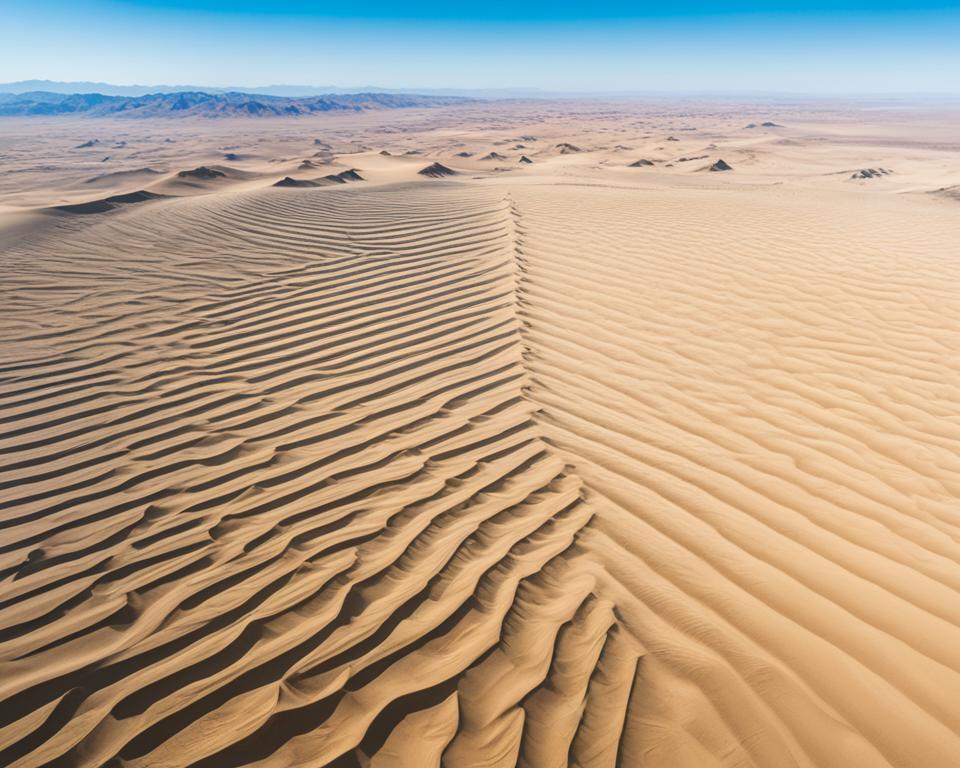
Discovering the Karez System: An Engineering Marvel
Xinjiang holds a special secret, the karez system. This ancient network has helped people survive for many years. It’s a unique part of Xinjiang, where water is scarce. For centuries, it has been key for handling water and farming.
Unveiling the Ancient Irrigation Techniques
Deep dive into the karez system. You’ll see the smart ways the locals used to get and use water. This system, called the “Lifeline of the Oasis,” captures water from snowmelt and the ground. Then it carries it to farms through a network of tunnels.
Sustainable Water Management in Xinjiang
The karez system is still crucial in Xinjiang today. It helps manage water and supports farming. Its clever design has let Xinjiang use less water and still do well. This shows how old ways and new methods can work together.
Xinjiang’s Breathtaking Landscapes: A Photographer’s Dream
Xinjiang is a photographer’s paradise with its varied and stunning landscapes. It’s home to the Heavenly Lake, with its serene blue waters, and the Flaming Mountains, known for their red rocks. These places are perfect for capturing the beauty of xinjiang’s scenery, photography, and nature.
Capturing the Essence of Nature’s Masterpieces
In Xinjiang, you’ll find contrasts like snowy peaks next to green valleys and desert dunes meeting lakes. The changing light and seasons make the region a wonder for photographers. It offers chances to show xinjiang’s dynamic and beautiful nature in your photos.
Photographing can include the peaceful Heavenly Lake or the dramatic Flaming Mountains at sunset. Xinjiang is full of ever-changing yet awe-inspiring scenes to capture. It’s a place where your efforts to take stunning photos are well worth it.
Best Photography Spots and Tips
For the best Xinjiang photos, visit top spots and get tips from experienced photographers. Look for places like the Heavenly Lake’s overlooks and Flaming Mountains’ hidden trails. These spots will boost your creativity and help you take unique photos.
Plan for the tough climate and rocky terrain. Bring durable photo equipment and stay ready for weather changes. With the right approach and gear, exploring Xinjiang can lead to finding photo treasures. It makes the region perfect for anyone who loves xinjiang’s beauty, photography, and nature.
Immersing in the Local Culture and Traditions
Going to Xinjiang means more than seeing sights. It’s diving deep into the area’s vibrant culture. You’ll feel the kindness of the Uyghur people right away. They’re proud of their traditions and history.
Experiencing Authentic Uyghur Hospitality
The Uyghur are known for their warm welcomes and cultural pride. Imagine visiting a Uyghur family’s house. There, you could have a traditional meal and talk. It’s a chance to understand the Uyghur culture and their old lifestyle.
Participating in Cultural Events and Festivals
Join in on the colorful cultural events and festivals. They highlight the Xinjiang culture and its many groups. You don’t want to miss the Meshrep. It’s where music and dance tell the story of the Uyghur culture.
Or see Eid al-Fitr celebrations. This is when Uyghur and other groups mark the end of Ramadan together. These events truly bring the region’s Xinjiang festivals to life. It’s a window into their treasured traditions.
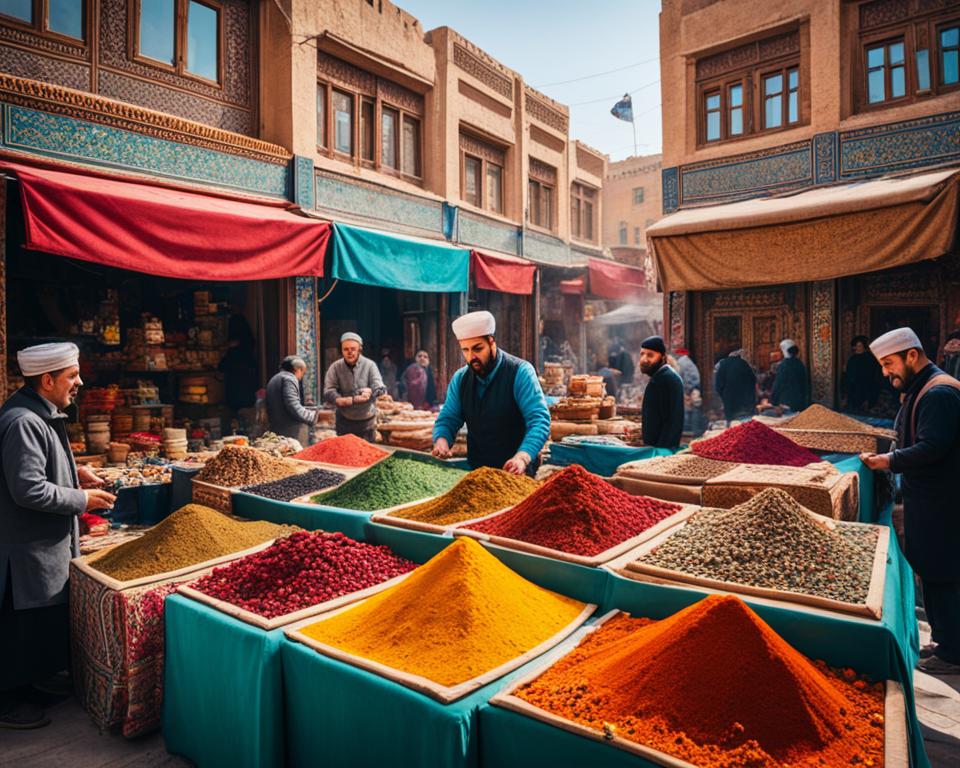
Adventure and Outdoor Activities in Xinjiang
Xinjiang’s vast and rugged terrains are a paradise for adventure lovers. You can find everything from tough treks to simple day hikes, offering plenty to do outdoors. It’s a region that invites you to explore, discover, and feel the thrill of adventure.
Trekking and Hiking Opportunities
Head out on foot to see the beauty of Xinjiang’s xinjiang adventure landscape. The Tianshan Mountains stand tall with their peaks and shimmering lakes. They are perfect for hard treks. But, if you prefer easier paths, there are beautiful trails near the xinjiang hiking Heavenly Lake too.
Exploring the Great Outdoors
Xinjiang also holds a mix of xinjiang outdoor activities for more excitement. Picture yourself on a camel trek in the Taklamakan Desert or having fun in the Flaming Mountains. You can even visit the old karez system. No matter your taste, Xinjiang’s natural beauty guarantees a memorable adventure.
Responsible Tourism in Xinjiang
Planning a trip to xinjiang? Make sure to follow responsible tourism. This means caring for the communities and protecting nature and culture. By choosing xinjiang sustainable tourism, you help the environment and the local economy.
Sustainable Travel Practices
When in xinjiang, try to cut down on waste and save resources. Pick places to stay that care for the planet. Avoid using plastic once and then throw things away properly. Join efforts to preserve nature and be careful when you’re out in the wild.
Respecting Local Customs and Etiquette
Learn about xinjiang travel etiquette and what the Uyghur and other locals do. Wear clothes that show respect, follow their traditions, and take part in their way of life. Doing this not only makes travel better but also builds friendships and understanding of different cultures.
Conclusion
Xinjiang is a special place with tourist attractions that are truly captivating. Its deep-rooted culture and stunning nature scenes are unforgettable. You can visit the peaceful Heavenly Lake, see historic Silk Road sites, taste Uyghur food, or try exciting outdoor activities.
Exploring Xinjiang means finding something for everyone. You can see the famous Flaming Mountains and enjoy the Muqam cultural shows. Don’t miss the ancient karez system, try real Uyghur food, and take photos of the amazing landscapes.
When traveling in Xinjiang, respect the local ways and help protect their environment. Enjoy the kindness of the Uyghur people. Your trip can be both fun and help save Xinjiang’s unique culture and nature. Take the chance to see this hidden treasure in China.
